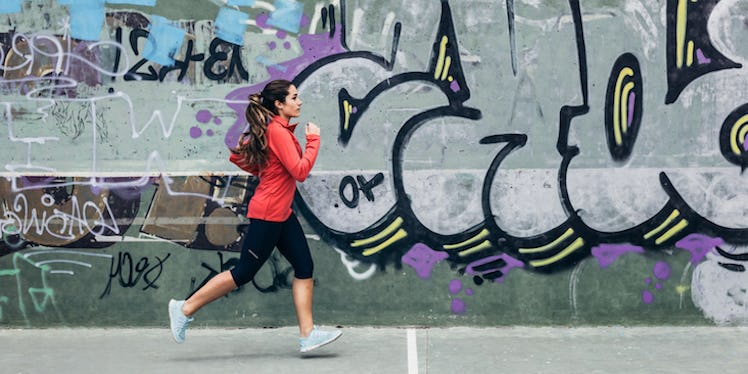
5 Things You Should Know Before You Take NSAIDs To Relieve Workout Pain
I used to train for marathons, and any seasoned runner knows that a 13-mile training run is a recipe for soreness in every. Damn. Muscle.
Ice baths, occasional massages, and ibuprofen became my BFFs after long run days.
Seriously, carrying a bottle of Advil in my bag felt as normal as throwing in a pack of spearmint gum -- because that's just what you're supposed to do for aches and pains, right?
Actually, recent research says that I may have been sorely mistaken.
According to the New York Times, taking ibuprofen and other similar, over-the-counter painkillers could have some pretty bad consequences for people who regularly exercise.
Apparently, 75 percent of long-distance runners take ibuprofen or other non-steroidal anti-inflammatory drugs (NSAIDs) before, during, or after training and races.
But these painkillers might ironically be causing more pain than relief.
Elite Daily spoke with Shoshana Gelb, clinical director at Professional Physical Therapy, to learn more about what NSAIDs really do to your body.
Here are five things you should know the next time you're tempted to go ahead and pop an ibuprofen after the gym.
1. Ibuprofen Isn't Always The Best Option For Inflammation
Gelb dishes out a healthy serving of #science and tells Elite Daily straight up why you should ditch over-the-counter meds:
After performing an aerobic activity that already increases blood pressure and heart rate, such as running, NSAIDs may not be the best option to eliminate inflammation. They can be linked to further raising blood pressure, and may increase the risk for heart failure and atrial fibrillation [an irregular and usually rapid heart beat that can lead to poor blood flow].
She goes on to say that the disturbance in heart rhythm can lead to blood clots, creating a whole slew of other health complications.
Yikes. Advil, why must you do me like this?
2. You Might Just Be Dehydrated
When you find yourself tempted to take a Tylenol for your hurting hammies, think about how much H2O you actually had that day, because it may play a bigger role than you'd think.
Gelb tells Elite Daily,
About 10 to 15 minutes after a run, it's important to drink water or an electrolyte beverage. As the body tends to sweat a good amount with running, [it] will need to rehydrate to replenish fluid loss.
Dehydration can lead to muscle cramping and stiffness, so listen to your bod, and drink up.
3. NSAIDS Can Cause Kidney And Muscle Tissue Problems
When it comes to the kidneys, there's no kidding around.
Gelb explains why you can definitely have too much of a good thing when it comes to seemingly harmless painkillers like ibuprofen:
According to recent studies, the most common renal complication is fluid retention. Extra fluid being trapped in the body's tissues can further increase [swelling] in the body. With fluid retention, the body retains more sodium, which can further be related to reducing kidney function.
So, while yo may not necessarily have to lay off these over-the-counter meds entirely, be sure not to make a habit of taking them after every single workout.
4. There Are Alternative Ways To Ease Post-Running Muscle Tension
Luckily, NSAIDS aren't the only option for your aching achilles.
Massages, ice baths, stretching, and warm epsom salt baths are all suitable ways to relieve muscle tension and soreness after running.
Gelb says,
Massage helps to bring blood flow to the area. This can help to promote healing and decrease inflammation, as well as alleviate muscle tension/tightness by loosening up muscles after activity.
If you're crunched for cash and can't afford a masseuse, foam rolling is basically a way to give yourself a personal deep-tissue massage.
Oh, and as tempting as it may seem, you're not going to want to skip out on stretching after you pound the pavement.
Gelb tells Elite Daily that the prolonged hold of your muscles that occurs during stretching helps create new muscle length tension relationships.
5. Or Physical Therapy Might Be The Answer To Your Post-Run Prayers
The next time you're thinking of buying that family-sized box of Advil at Costco, you might want to consider looking into physical therapy instead.
Gelb describes some of the pros of physical therapy,
Physical therapy combines a treatment of manual techniques, modalities, and exercise to treat acute symptoms, decrease pain and inflammation, and prevent re-injury.
She adds that most running injuries come from overuse and repetitive activity, as well as faulty mechanics.
Physical therapy can address these deficits in flexibility and strength to decrease repetitive strain on an area of the body during running.
Bottom line: You should let your body do its own, natural thing and trust it to care for muscle soreness, using supplements like NSAIDs only in moderation.
But Advil is not the equivalent of your arctic mint gum -- treat it as a last resort, not a casual commonplace.